A Step-by-Step Damage Identification Method Based on Frequency Response Function and Cross Signature Assurance Criterion
Abstract
1. Introduction
2. Theory
2.1. Cross-Signature Assurance Criterion
2.2. Damage Index (DI) Formulation
2.3. Objective Function Formulation
- (1)
- The shape similarity of the FRF spectrum in the frequency domain can be directly used to reduce the influence of the systematic test errors in the specified frequency range;
- (2)
- When the objective function is constructed using the CSAC index between the adjacent measurement points of the structures, the total number of constraint equations can be increased by increasing the number of measurement points. The model is thus modified to effectively accommodate the number of parameters. When m + 1 measurement points are arranged, the number of CSAC exponents between the adjacent points is m, which is much higher than that of the constraint equations constructed using low order modes.
2.4. Optimization and Convergence Criteria
2.5. Damage Identification Process
- (1)
- Dividing the beam into sections and determining the sensor installation location. Thereafter, develop a FEM model of the beam for further analysis, which is denoted Section (A) in the flow chart in Figure 3.
- (2)
- Measuring the dynamic responses of the bridge during experimentation and quantitative estimations using theoretical methods with the FEM model. Thereafter, calculating the FRF and the corresponding CSAC indices, which is denoted as Section (B) in the flow chart.
- (3)
- Using the model updating method proposed in this paper to determine the DI for constructing the objective function, with respect to both the results obtained from the actual measurement and theoretical analysis, which is denoted as Section (C) in the flow chart.
- (4)
- The measurement elements and sensors are arranged uniformly as done in Step 1, although, the damaged element is refined into smaller elements and more sensors are used in this zone. If the objective function does not converge, then the DI α will be modified and consequently, the structural stiffness will be changed. This step can be iteratively repeated to approach the actual damage, which is denoted as Section (D) in Figure 3.
- (5)
- Correcting the finite element model and presenting the damage indices with respect to the analysis location and severity of the damage, as denoted in Section (E) of the flow chart in Figure 3.
3. Model Testing and Numerical Simulations
3.1. Beam Characteristics
3.2. Sensitivity Analysis of the CSAC Index Versus Frequency
3.3. Quantitative Analysis of the Beam Damage
3.4. Influence of Noise on Damage Identification
3.5. Step-by-Step Damage Identification Process
3.5.1. Initial Identification of the Damage Location
3.5.2. Damage Identification after Subdivision of the Elements
3.5.3. Identification of Damage Location and Severity
4. Laboratory Experimentation and Model Verification
4.1. Beam Fabrication
4.2. Test Equipment and Laboratory Setup
4.3. Damage Identification Using the Step-by-Step Method
4.3.1. Parameter Setting
4.3.2. Single Damage Identification (Case 1)
4.3.3. Double Damage Identification (Case 2)
5. Conclusions
- (1)
- When compared to traditional model updating methods, the results obtained with the proposed CSAC index exhibited satisfactory damage identification competence. The literature reviewed so far is limited in terms of integrating the CSAC index with FRF and model updating for better identification capability as demonstrated in this paper;
- (2)
- The CSAC index in the frequency range between the first two frequencies is found to be sensitive to damage. Thus, this frequency range can be used to identify the damage location and severity in simply supported beams;
- (3)
- The objective function can be constructed using CSAC indices of the FRFs between adjacent measurement points. The number of the constraint equations and the identification parameters can be effectively improved by increasing the number of measurement points;
- (4)
- The damage identification method proposed in this paper exhibits insensitivity to the systematic test error. Damage, both at single and multiple locations, can be well located and quantified in the presence of noise;
- (5)
- The step-by-step identification procedure can be used to accurately identify the damage location and determine the damage severity in simply supported beams.
Author Contributions
Funding
Institutional Review Board Statement
Informed Consent Statement
Data Availability Statement
Acknowledgments
Conflicts of Interest
References
- Oskoui, E.A.; Taylor, T.; Ansari, F. Method and monitoring approach for distributed detection of damage in multi-span continuous bridges. Eng. Struct. 2019, 189, 385–395. [Google Scholar] [CrossRef]
- Locke, W.; Sybrandt, J.; Redmond, L.; Safro, I.; Atamturktur, S. Using drive-by health monitoring to detect bridge damage considering environmental and operational effects. J. Sound Vib. 2020, 468, 115088. [Google Scholar] [CrossRef]
- Zhou, C.; Wu, Y.; Cui, G.; Zhang, A.; Gao, Y.; Wang, X.; Ouyang, J.; Sun, H.; Liang, Y.; Liu, Z.; et al. Comprehensive measurement techniques and multi-index correlative evaluation approach for structural health monitoring of highway bridges. Measurement 2020, 152, 107360. [Google Scholar] [CrossRef]
- Zhu, X.; Cao, M.; Ostachowicz, W.; Xu, W. Damage Identification in Bridges by Processing Dynamic Responses to Moving Loads: Features and Evaluation. Sensors 2019, 19, 463. [Google Scholar] [CrossRef]
- Yin, T.; Jiang, Q.; Yuen, K. Vibration-based damage detection for structural connections using incomplete modal data by Bayesian approach and model reduction technique. Eng. Struct. 2017, 132, 260–277. [Google Scholar] [CrossRef]
- Wickramasinghe, W.R.; Thambiratnam, D.P.; Chan, T.H.T.; Nguyen, T. Vibration characteristics and damage detection in a suspension bridge. J. Sound Vib. 2016, 375, 254–274. [Google Scholar] [CrossRef]
- Siriwardane, S.C. Vibration measurement-based simple technique for damage detection of truss bridges: A case study. Case Stud. Eng. Fail. Anal. 2015, 4, 50–58. [Google Scholar] [CrossRef]
- Rucevskis, S.; Janeliukstis, R.; Akishin, P.; Chate, A. Mode shape-based damage detection in plate structure without baseline data. Struct. Control Health Monit. 2016, 23, 1180–1193. [Google Scholar] [CrossRef]
- Wang, S.; Xu, M. Modal Strain Energy-based Structural Damage Identification: A Review and Comparative Study. Struct. Eng. Int. 2018, 29, 1–15. [Google Scholar] [CrossRef]
- Mondal, S.; Mondal, B.; Bhutia, A.; Chakraborty, S. Damage Detection in Beams Using Frequency Response Function Curvatures near resonating frequencies. In Advances in Structural Engineering; Springer: New Delhi, India, 2015; pp. 1563–1573. [Google Scholar]
- Avci, O.; Abdeljaber, O.; Kiranyaz, S.; Hussein, M.; Gabbouj, M.; Inman, D. A Review of Vibration-Based Damage Detection in Civil Structures: From Traditional Methods to Machine Learning and Deep Learning Applications. arXiv 2020, arXiv:2004.04373. [Google Scholar] [CrossRef]
- Ren, W.X.; De Roeck, G. Structural Damage Identification using Modal Data. II: Test Verification. J. Struct. Eng. 2002, 128, 96–104. [Google Scholar] [CrossRef]
- Peeters, B. System Identification and Damage Detection in Civil Engineering. Ph.D. Thesis, KU Leuven, Heverlee, Belgium, December 2000. [Google Scholar]
- Mousavi, A.A.; Zhang, C.; Masri, S.F.; Gholipour, G. Structural Damage Localization and Quantification Based on a CEEMDAN Hilbert Transform Neural Network Approach: A Model Steel Truss Bridge Case Study. Sensors 2020, 20, 1271. [Google Scholar] [CrossRef] [PubMed]
- Kildashti, K.; Alamdari, M.M.; Kim, C.W.; Gao, W.; Samali, B. Drive-by-bridge inspection for damage identification in a cable-stayed bridge: Numerical investigations. Eng. Struct. 2020, 223, 110891. [Google Scholar] [CrossRef]
- Zhan, J.; Zhang, F.; Siahkouhi, M.; Kong, X.; Xia, H. A damage identification method for connections of adjacent box-beam bridges using vehicle-bridge interaction analysis and model updating. Eng. Struct. 2021, 228, 111551. [Google Scholar] [CrossRef]
- Yan, Y.J.; Cheng, L.; Wu, Z.Y.; Yam, L.H. Development in vibration-based structural damage detection technique. Mech. Syst. Signal Process. 2007, 21, 2198–2211. [Google Scholar] [CrossRef]
- Carden, E.P. Vibration Based Condition Monitoring: A Review. Struct. Health Monit. 2004, 3, 355–377. [Google Scholar] [CrossRef]
- Shi, Z.Y.; Law, S.S.; Zhang, L.M. Improved Damage Quantification from Elemental Modal Strain Energy Change. J. Eng. Mech. 2002, 128, 521–529. [Google Scholar] [CrossRef]
- Law, S.S.; Zhang, K.; Duan, Z.D. Structural damage detection from coupling forces between substructures under support excitation. Eng. Struct. 2010, 32, 2221–2228. [Google Scholar] [CrossRef]
- Galvanetto, U.; Surace, C.; Tassotti, A. Structural Damage Detection Based on Proper Orthogonal Decomposition: Experimental Verification. AIAA J. 2008, 46, 1624–1630. [Google Scholar] [CrossRef]
- Esfandiari, A.; Bakhtiari-Nejad, F.; Rahai, A.; Sanayei, M. Structural model updating using frequency response function and quasi-linear sensitivity equation. J. Sound Vib. 2009, 326, 557–573. [Google Scholar] [CrossRef]
- Ren, W.X.; De Roeck, G. Structural Damage Identification using Modal Data. I: Simulation Verification. J. Struct. Eng. 2002, 128, 87–95. [Google Scholar] [CrossRef]
- Shadan, F.; Khoshnoudian, F.; Esfandiari, A. A frequency response-based structural damage identification using model updating method. Struct. Control Health Monit. 2016, 23, 286–302. [Google Scholar] [CrossRef]
- Dascotte, A.E.; Strobbe, J. Updating Finite Element Models Using FRF Correlation Functions. In Proceedings of the IMAC XVII: 17th International Modal Analysis Conference, Kissimmee, FL, USA, 8–11 February 1999; pp. 1169–1174. [Google Scholar]
- Lin, R.M.; Zhu, J. Model updating of damped structures using FRF data. Mech. Syst. Signal Process. 2006, 20, 2200–2218. [Google Scholar] [CrossRef]
- Ting, T. Design Sensitivity Analysis of Structural Frequency Response. AIAA J. 1993, 31, 1965–1967. [Google Scholar] [CrossRef]
- Guo, N.; Yang, Z.; Jia, Y.; Wang, L. Model updating using correlation analysis of strain frequency response function. Mech. Syst. Signal Process. 2016, 70, 284–299. [Google Scholar] [CrossRef]
- Esfandiari, A. Structural model updating using incomplete transfer function of strain data. J. Sound Vib. 2014, 333, 3657–3670. [Google Scholar] [CrossRef]
- Sipple, J.D.; Sanayei, M. Finite element model updating using frequency response functions and numerical sensitivities. Struct. Control Health Monit. 2014, 21, 784–802. [Google Scholar] [CrossRef]
- Cheung, S.H.; Beck, J.L. Bayesian Model Updating Using Hybrid Monte Carlo Simulation with Application to Structural Dynamic Models with Many Uncertain Parameters. J. Eng. Mech. 2009, 135, 243–255. [Google Scholar] [CrossRef]
- Imregun, M.; Visser, W.J.; Ewins, D.J. Finite element model updating using frequency response function data: I. Theory and initial investigation. Mech. Syst. Signal Process. 1995, 9, 187–202. [Google Scholar] [CrossRef]
- Wahab, M.A.; De Roeck, G.; Peeters, B. Parameterization of damage in reinforced concrete structures using model updating. J. Sound Vib. 1999, 228, 717–730. [Google Scholar] [CrossRef]
- Yin, T.; Zhu, H.P. Probabilistic Damage Detection of a Steel Truss Bridge Model by Optimally Designed Bayesian Neural Network. Sensors 2018, 18, 3371. [Google Scholar] [CrossRef]
- Zhang, Z.; Sun, C. Structural damage identification via physics-guided machine learning: A methodology integrating pattern recognition with finite element model updating. Struct. Health Monit. 2020. [Google Scholar] [CrossRef]
- Zhang, Z.; Sun, C. Multi-site structural damage identification using a multi-label classification scheme of machine learning. Measurement 2020, 154, 107473. [Google Scholar] [CrossRef]
- Abdeljaber, O.; Avci, O.; Kiranyaz, S.; Gabbouj, M.; Inman, D.J. Real-time vibration-based structural damage detection using one-dimensional convolutional neural networks. J. Sound Vib. 2017, 388, 154–170. [Google Scholar] [CrossRef]
- Esfandiari, A.; Rahai, A.; Sanayei, M.; Bakhtiari-Nejad, F. Model Updating of a Concrete Beam with Extensive Distributed Damage Using Experimental Frequency Response Function. J. Bridge Eng. 2016, 21, 04015081. [Google Scholar] [CrossRef]
- Sanayei, M.; Phelps, J.E.; Sipple, J.D.; Bell, E.S.; Brenner, B.R. Instrumentation, Nondestructive Testing, and Finite-Element Model Updating for Bridge Evaluation Using Strain Measurements. J. Bridge Eng. 2012, 17, 130–138. [Google Scholar] [CrossRef]


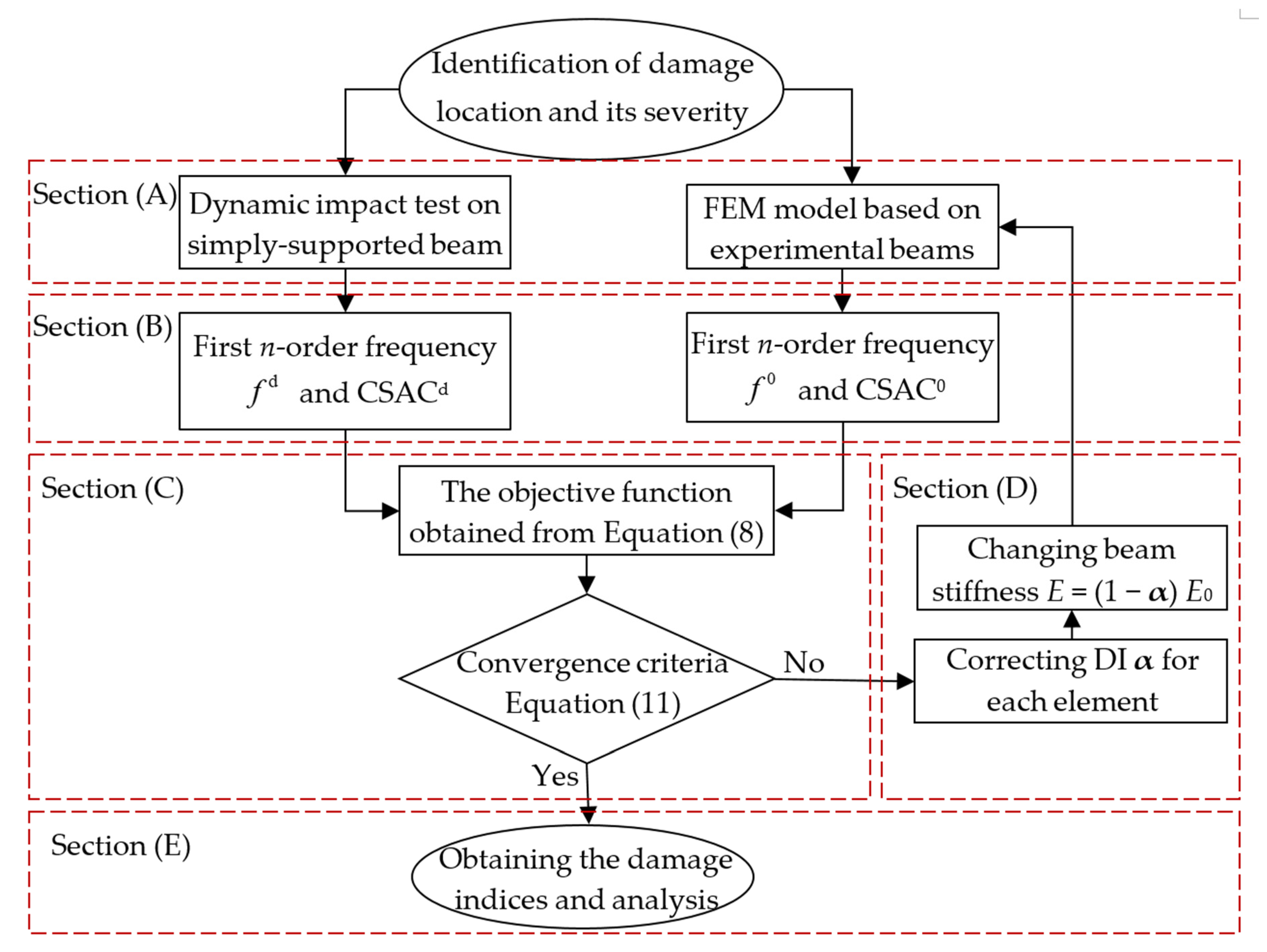

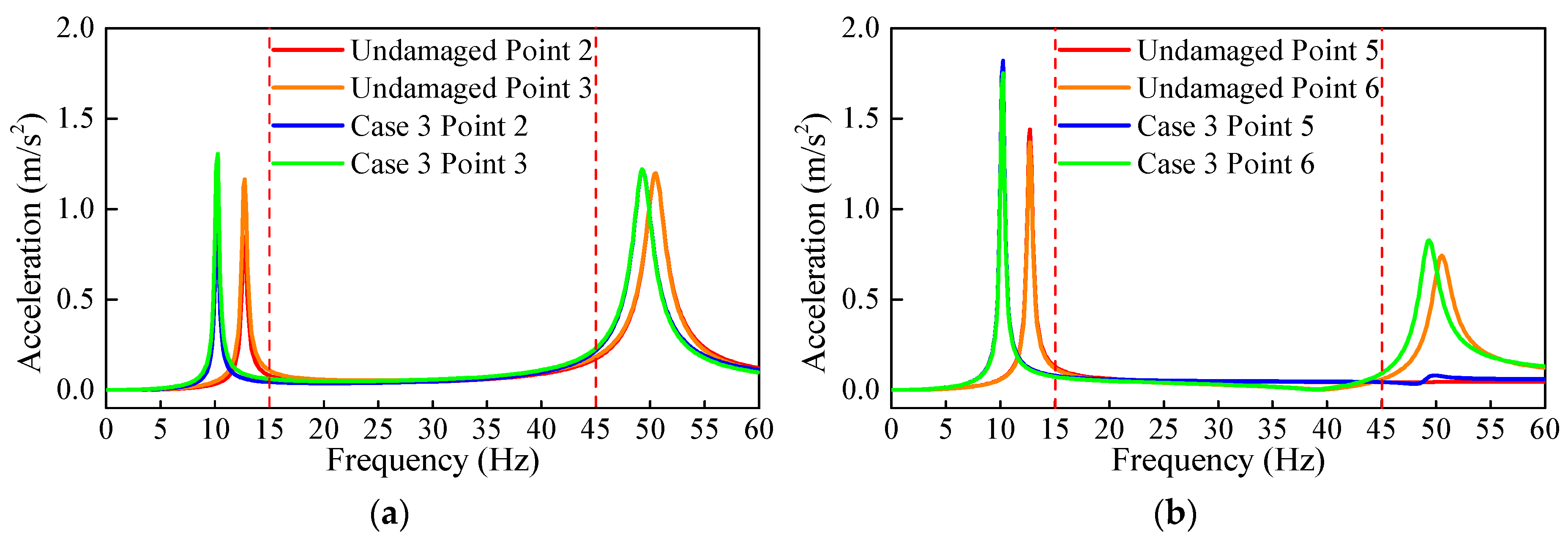
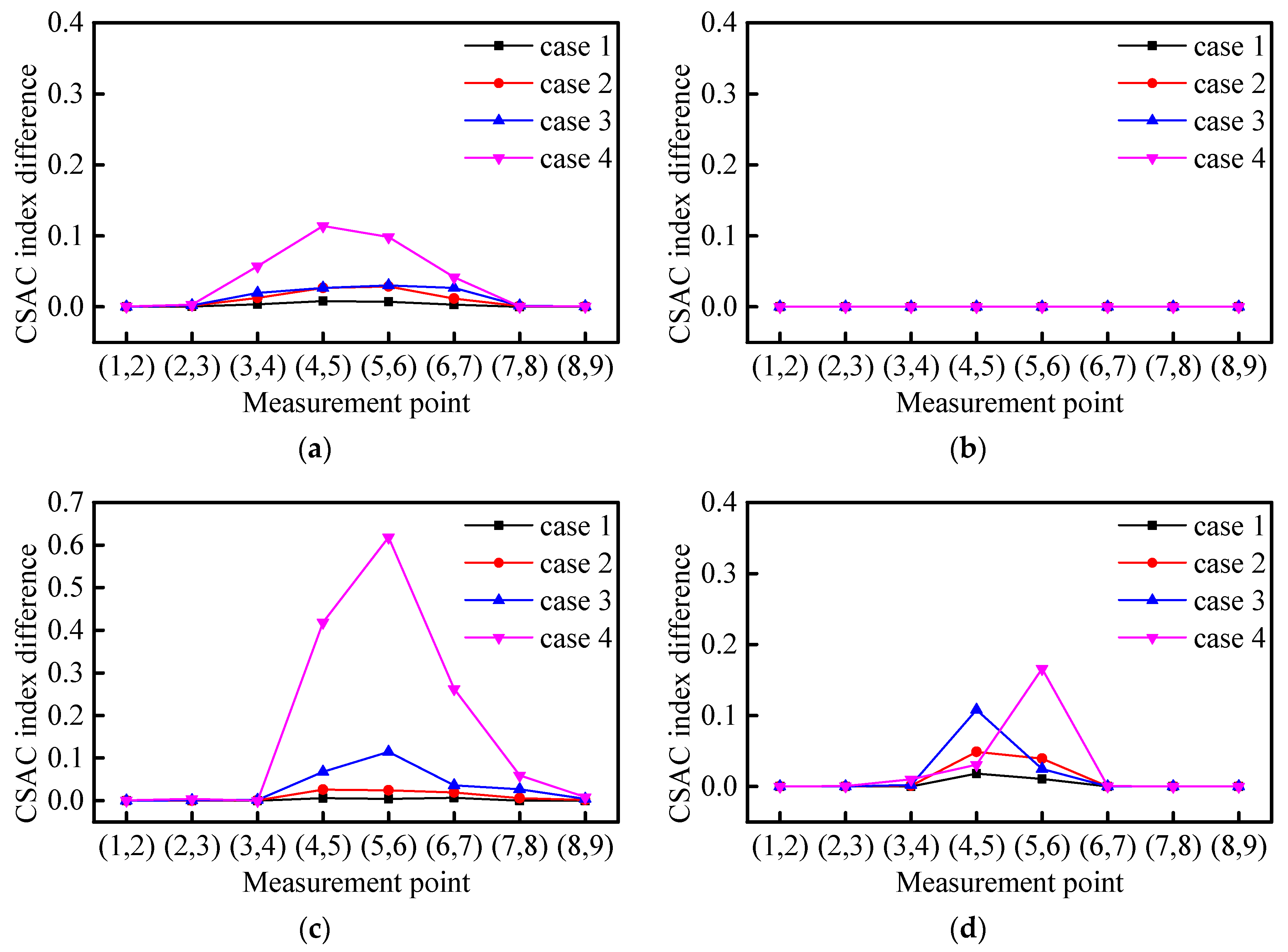



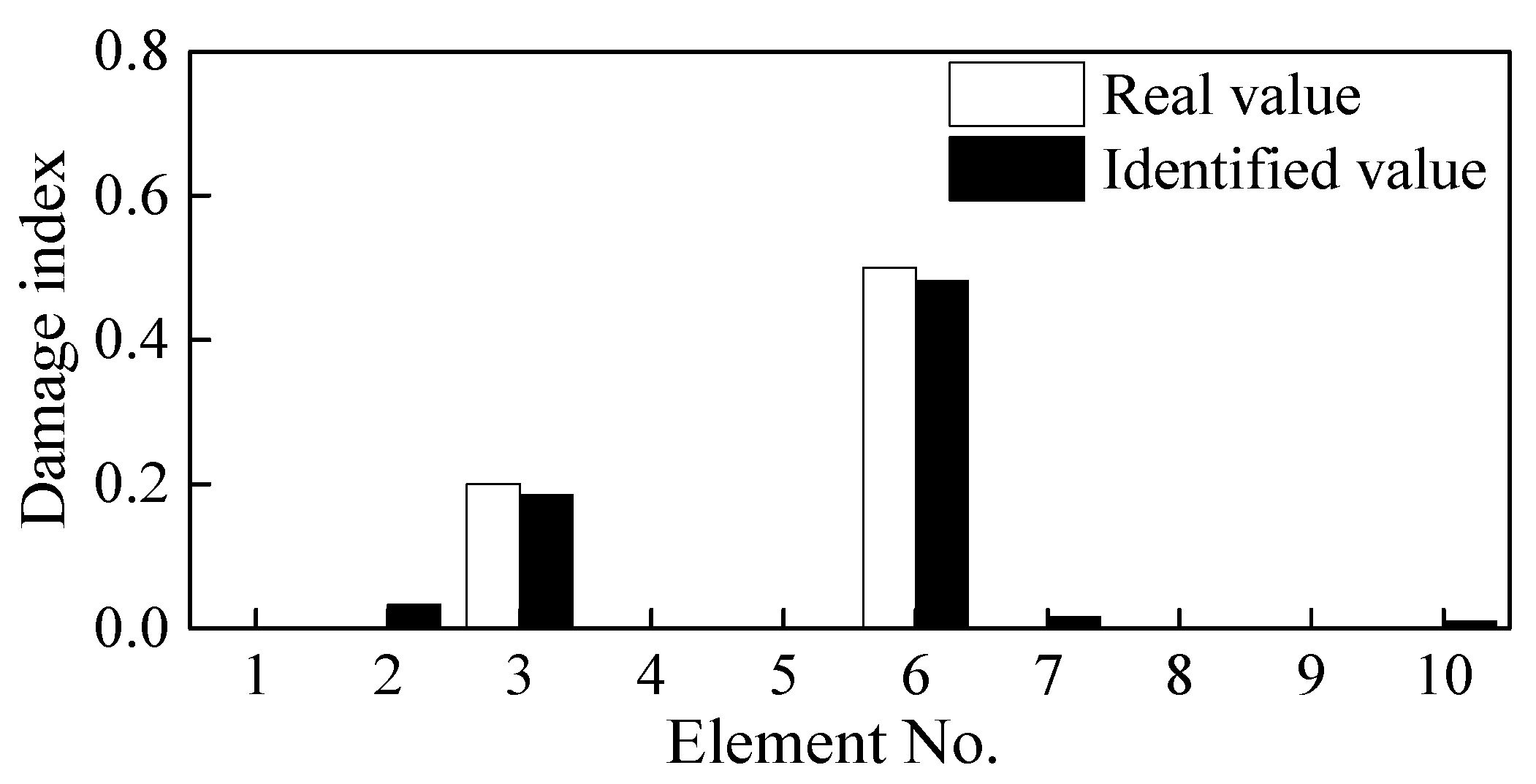
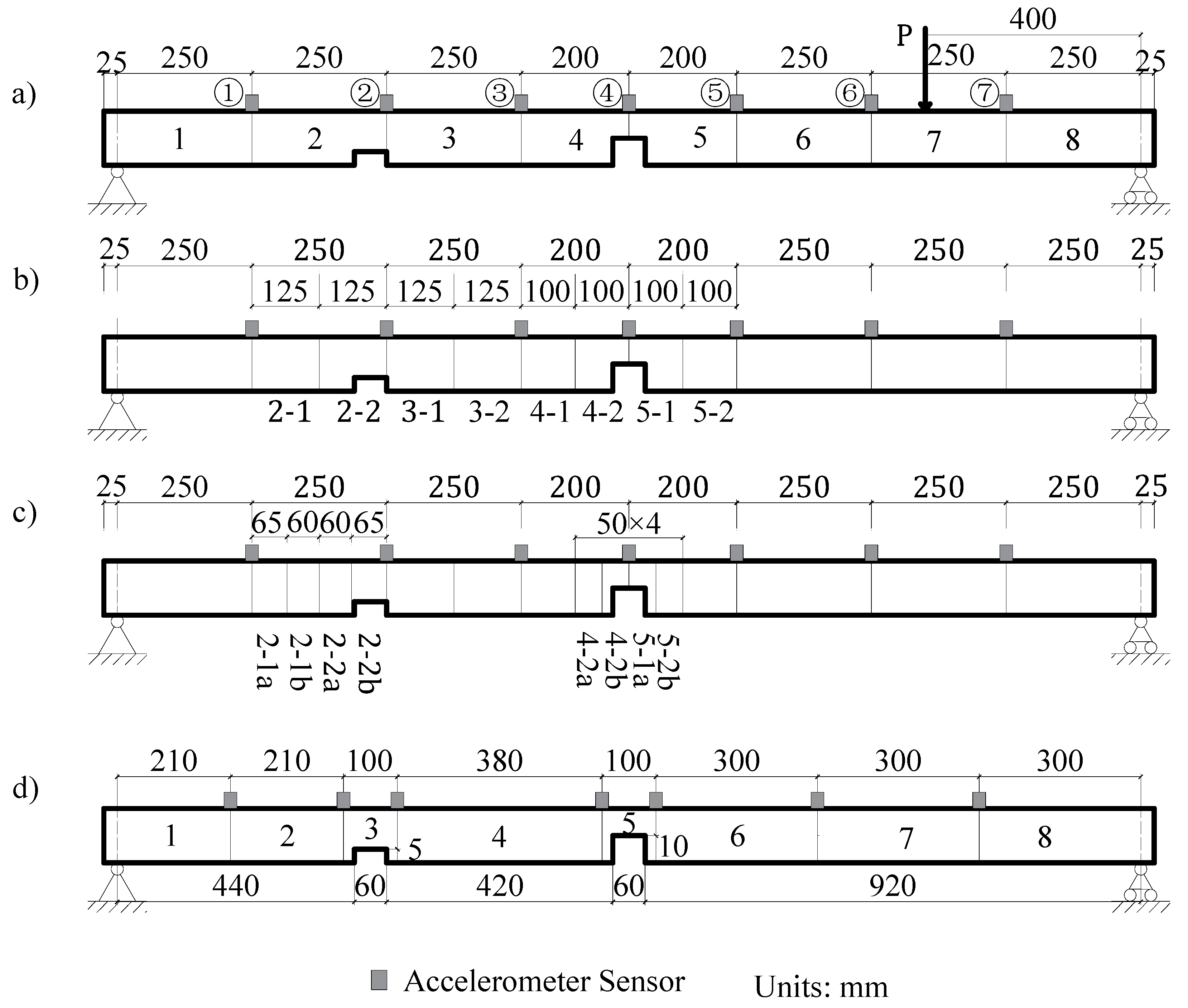

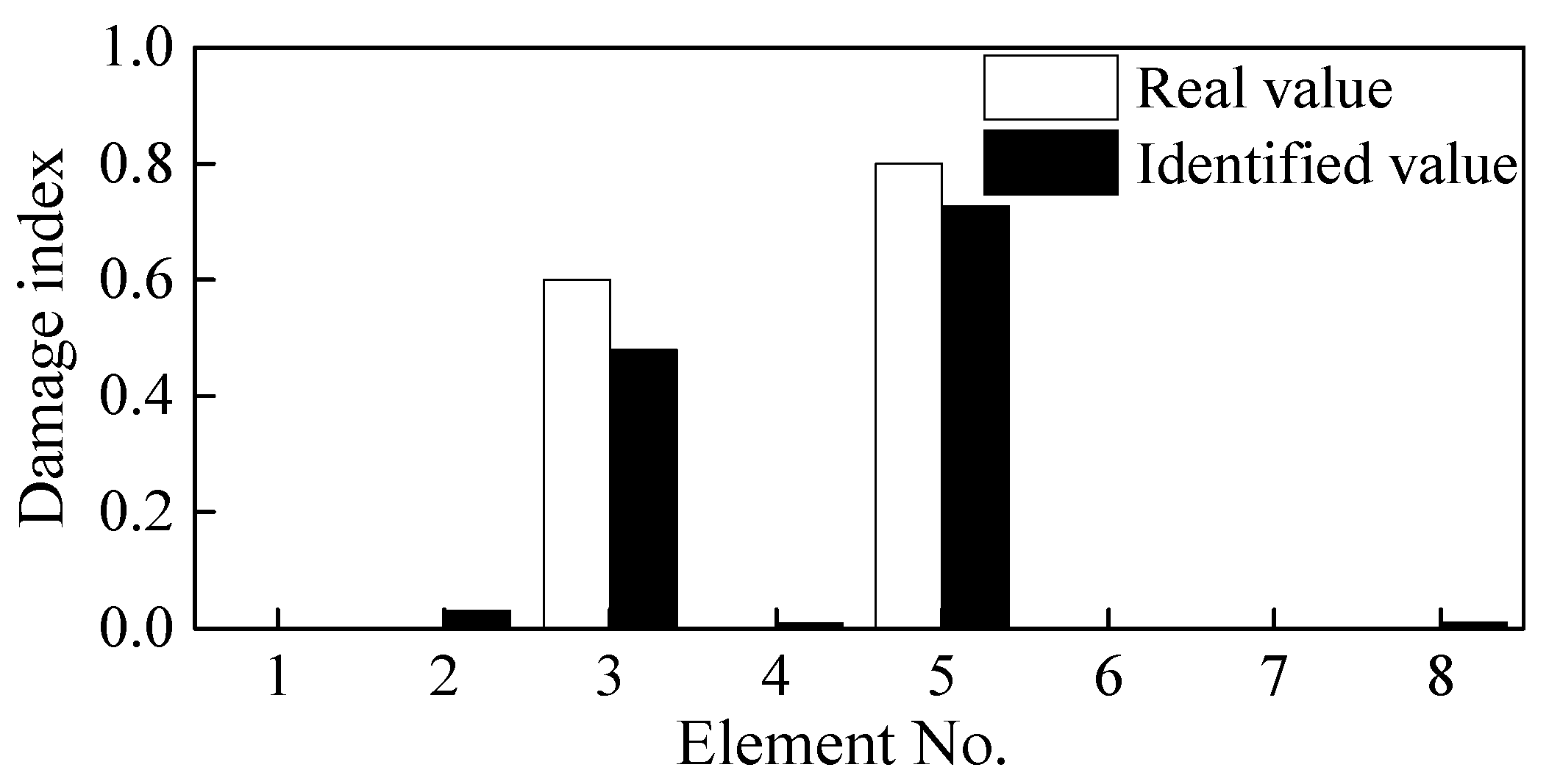

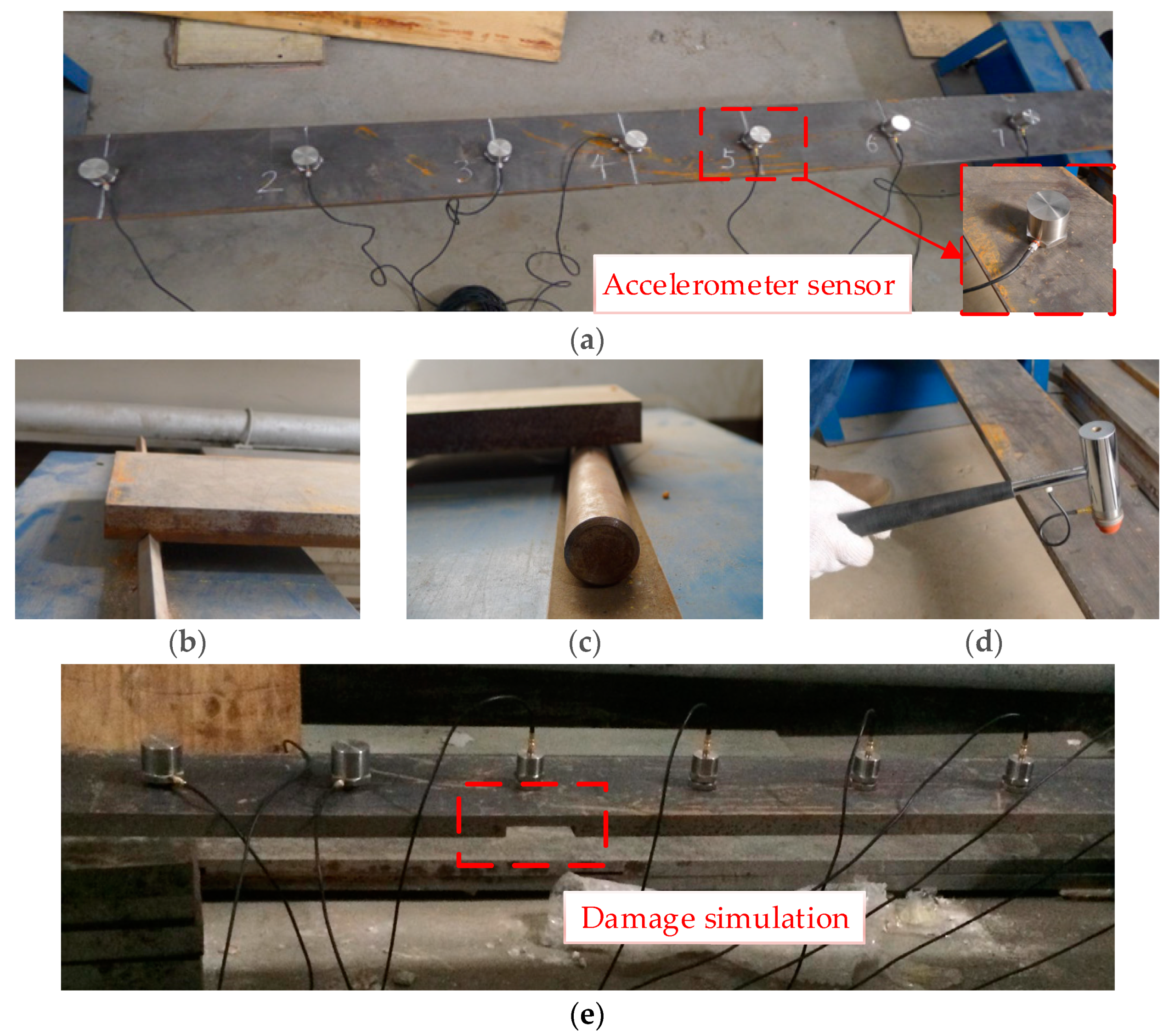



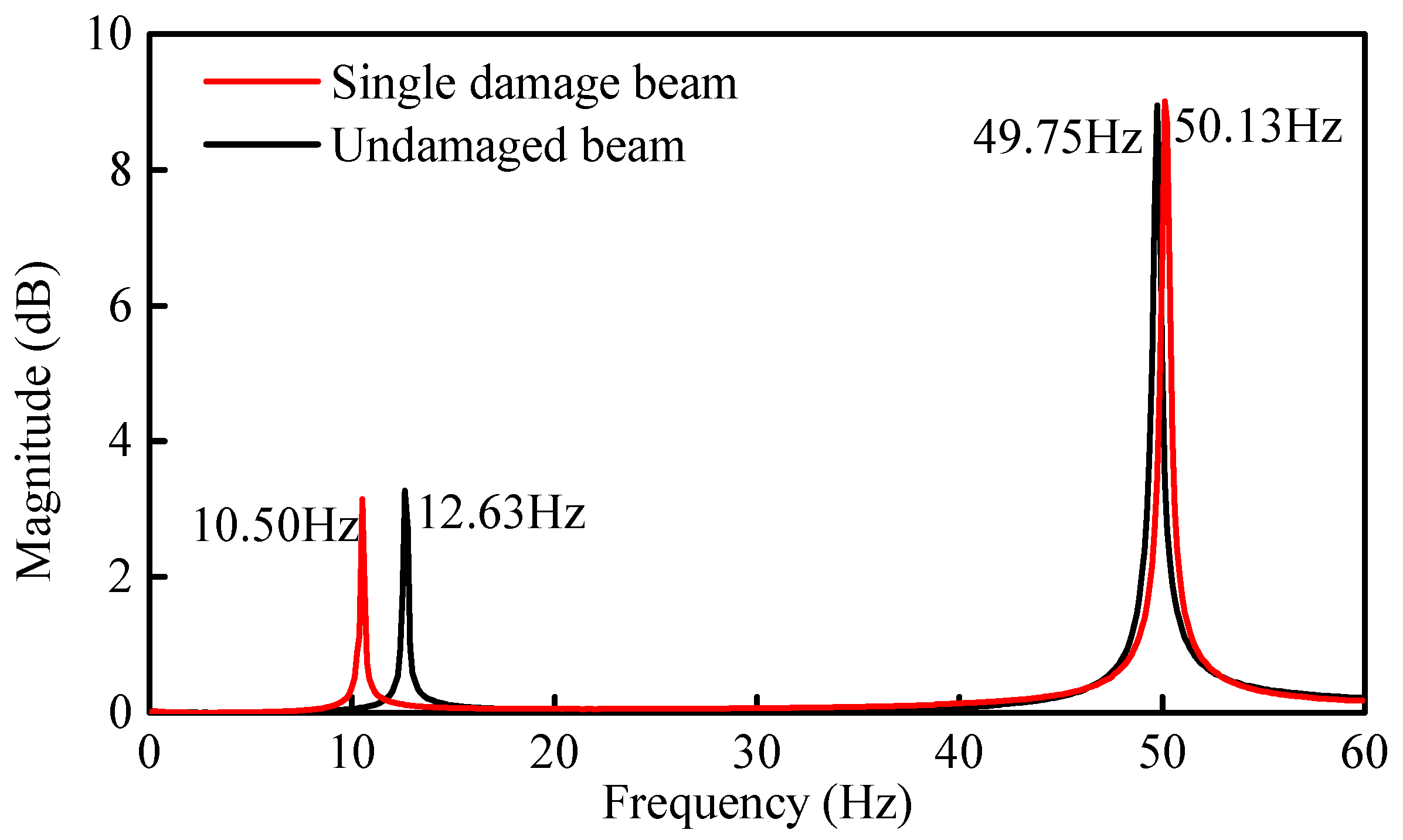

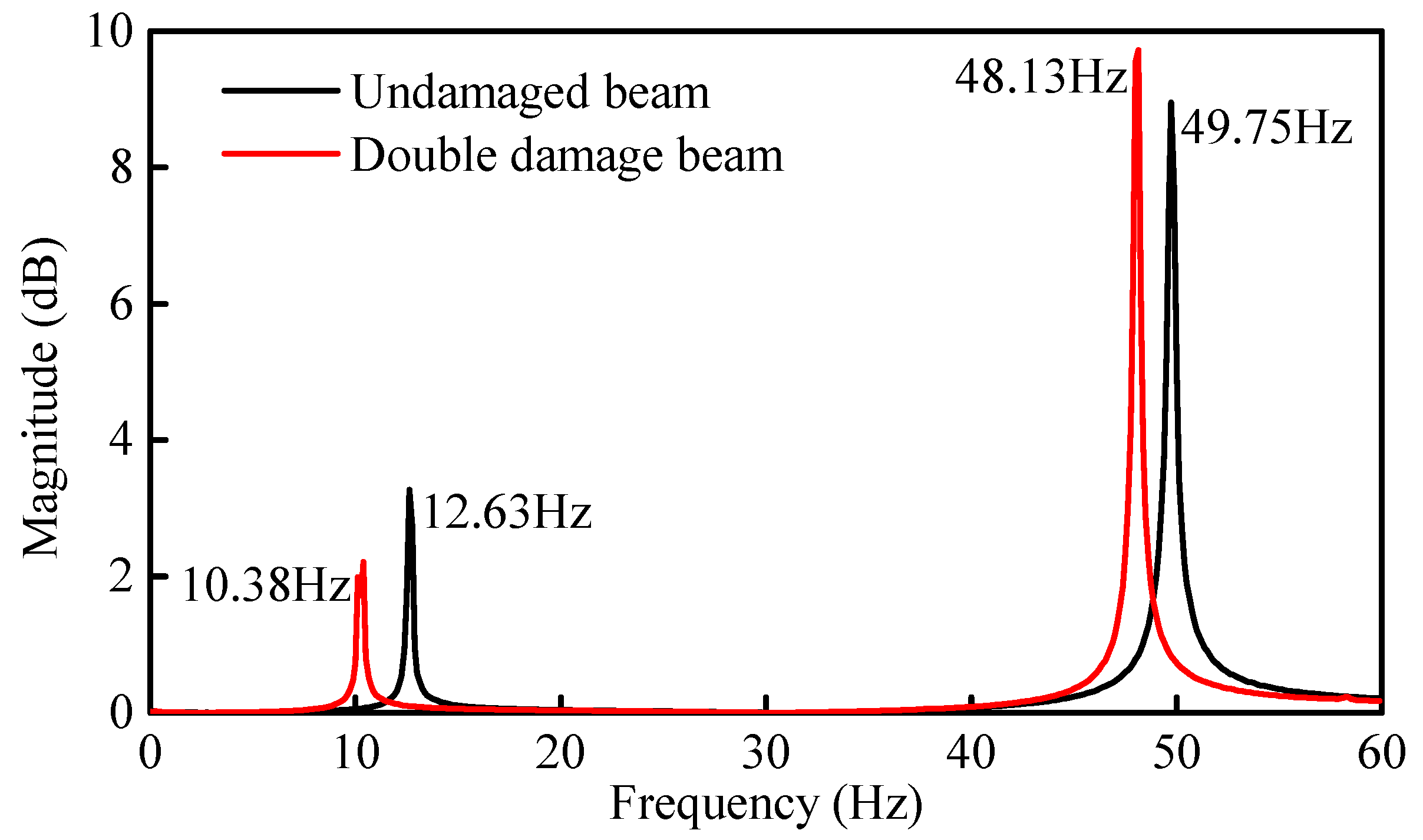


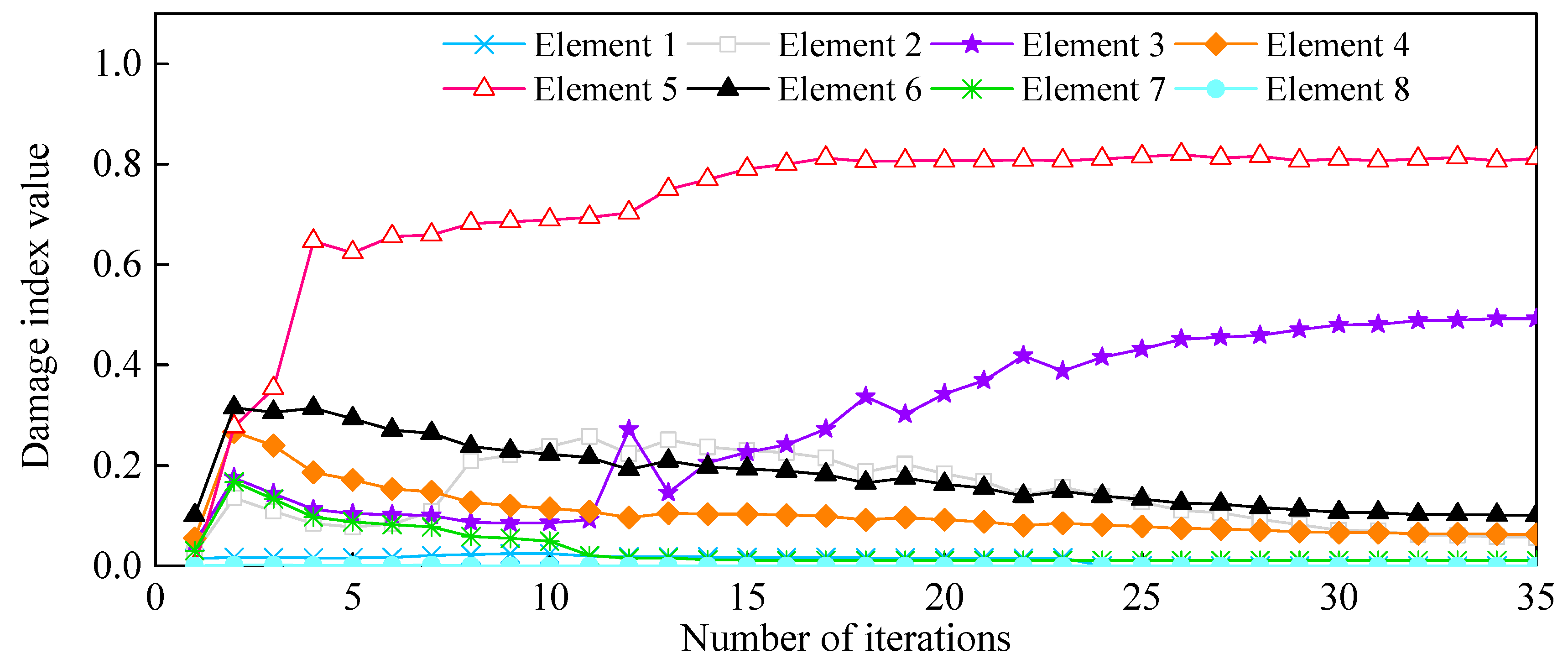
| Damage Cases | Damage Elements | DI |
|---|---|---|
| Case 1 | No. 6 | 0.1 |
| Case 2 | No. 6 | 0.3 |
| Case 3 | No. 6 | 0.5 |
| Case 4 | No. 3, No. 6 | 0.2, 0.5 |
| Frequency Range Number | Selection of Frequency | Frequency Range (Hz) |
|---|---|---|
| 1 | Contains first two natural frequency | 0~60 |
| 2 | Contains only first natural frequency | 0~15 |
| 3 | between first and second natural frequencies | 15~45 |
| 4 | Contains only second natural frequency | 45~60 |
| Damage Cases | Damage Location | Cross-Cut Sectional Depth (Δh) | DI (α) |
|---|---|---|---|
| Case 1 | middle of the beam | 10 mm | 0.875 |
| Case 2 | 1/4, 1/2 span of the beam | 5 mm, 10 mm | 0.578, 0.875 |
Publisher’s Note: MDPI stays neutral with regard to jurisdictional claims in published maps and institutional affiliations. |
© 2021 by the authors. Licensee MDPI, Basel, Switzerland. This article is an open access article distributed under the terms and conditions of the Creative Commons Attribution (CC BY) license (http://creativecommons.org/licenses/by/4.0/).
Share and Cite
Zhan, J.; Zhang, F.; Siahkouhi, M. A Step-by-Step Damage Identification Method Based on Frequency Response Function and Cross Signature Assurance Criterion. Sensors 2021, 21, 1029. https://doi.org/10.3390/s21041029
Zhan J, Zhang F, Siahkouhi M. A Step-by-Step Damage Identification Method Based on Frequency Response Function and Cross Signature Assurance Criterion. Sensors. 2021; 21(4):1029. https://doi.org/10.3390/s21041029
Chicago/Turabian StyleZhan, Jiawang, Fei Zhang, and Mohammad Siahkouhi. 2021. "A Step-by-Step Damage Identification Method Based on Frequency Response Function and Cross Signature Assurance Criterion" Sensors 21, no. 4: 1029. https://doi.org/10.3390/s21041029
APA StyleZhan, J., Zhang, F., & Siahkouhi, M. (2021). A Step-by-Step Damage Identification Method Based on Frequency Response Function and Cross Signature Assurance Criterion. Sensors, 21(4), 1029. https://doi.org/10.3390/s21041029








